-
 How to Start a Small Clothing Business from Home(2025)
How to Start a Small Clothing Business from Home(2025)Getting started is often the hardest part of anything. We tend to overthink, overcomplicate, and hold ourselves back—especially when we don’t have a clear, actionable plan. But if you’ve just typed “how to start a small clothing business from home” into a search bar and landed on this article—congratulations. You’ve already taken the first step toward building something of your own.
Starting a small-scale clothing business from home isn’t as hard as it used to be. In today’s digital world, it's more accessible than ever. This blog post will walk you through the entire process step by step, helping you turn your idea into a real, working business—right from your living room.
1. Define Your Niche and Target Audience
The foundation of any successful clothing brand lies in a clear niche and a well-understood target audience. You can’t market to everyone—so don’t try. Instead, identify what makes your style or message unique.
Start by asking yourself:
l What kind of clothing do I want to create? (e.g., sustainable basics, streetwear, plus-size fashion, kidswear, cultural designs)
l Who is my ideal customer? Age, values, lifestyle, and spending habits?
l What problem does my clothing solve?
Research fashion trends on Pinterest, Instagram, and TikTok. Use tools like Google Trends or AnswerThePublic to see what people are searching for. Validate your ideas with friends, forums, or small test sales on platforms like Etsy.
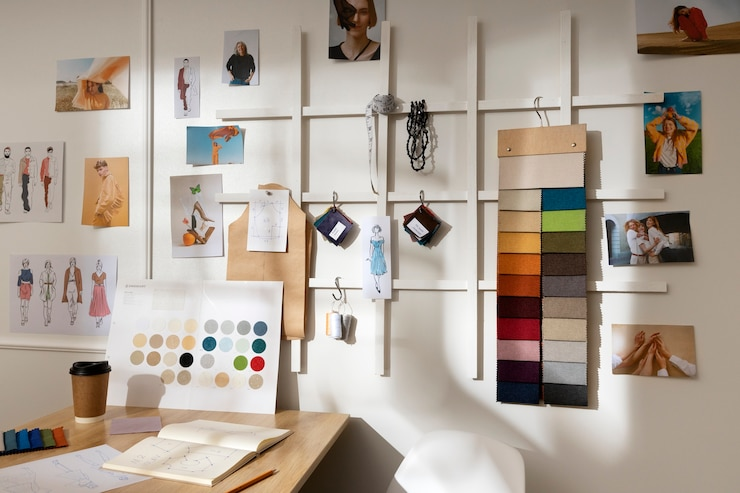
2. Choose the Right Business Model
Once your niche is defined, select a business model that aligns with your skills, budget, and growth goals:
l Print-on-Demand (POD)
Ideal for graphic tees, hoodies, or athleisure. You upload designs to a platform (like Printful or Printify), and products are printed and shipped only when ordered. No inventory, low startup cost.l Handmade
Perfect for artisans or sewing hobbyists. You create each item by hand, offering exclusivity and craftsmanship—but production time is limited by your personal capacity.l Private Label
This involves working with manufacturers to produce custom designs under your own brand. Higher control over quality, but requires investment in inventory and product development.l Dropshipping
You handle the branding and marketing, while a supplier ships directly to your customer. Low risk, but less control over quality and delivery times.Each option has trade-offs between cost, control, and scalability. Choose a model you can realistically manage and grow into.
3. Develop a Business Plan
Your business plan is your roadmap—and a critical tool if you ever seek funding or partnerships. Even if you're starting solo, a clear plan keeps you focused.
Key components include:
l Brand Vision & Mission: Define what your brand stands for and how it will make a difference.
l Market Analysis: Understand your competition and your customer’s unmet needs.
l Product Line: Detail what items you’ll offer and how they support your niche.
l Marketing Strategy: Describe your customer acquisition plan through channels like social media, content, email, and collaborations.
l Financials: Estimate startup costs (equipment, website, marketing), profit margins, and
pricing structure.
Even a simple spreadsheet and 3-page PDF can serve as a functional starter plan.
4. Set Up Your Home Workspace
A well-organized, dedicated workspace is key to productivity—especially when your home is also your headquarters.
Essentials for a clothing business might include:
l Designated area: Whether it’s a spare bedroom or sectioned-off corner, having a "business-only" zone keeps you focused.
l Tools & Equipment: Sewing machines, cutting tables, printers, labelers, mannequins, lighting kits (for product photography).
l Storage: Use clear bins, garment racks, drawer organizers, and label makers to keep your materials and products in order.
Invest in ergonomic seating and adequate lighting. Clutter can kill creativity and slow down your workflow.
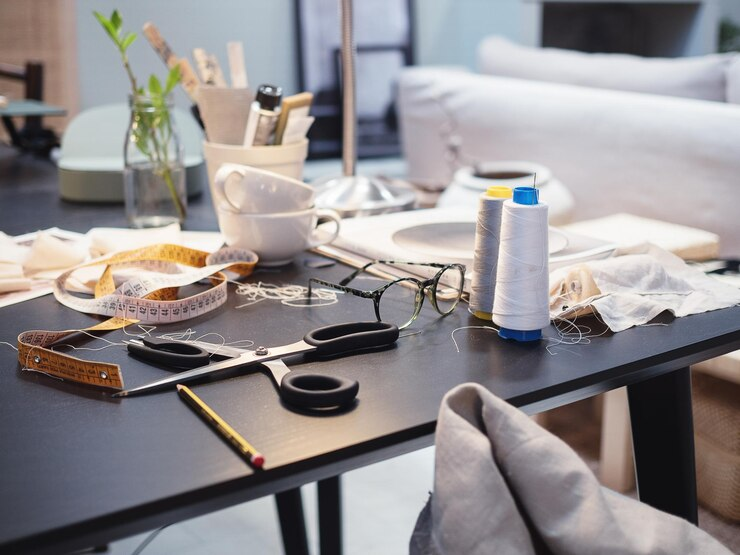
5. Build Your Brand Identity
People buy brands, not just clothes. Your brand identity is how you communicate your values, vibe, and style.
Consider:
l Name: It should be unique, easy to spell, and evoke your aesthetic.
l Logo & Colors: A clean, scalable logo and a consistent color palette make your brand recognizable across platforms.
l Voice: Think about how your brand "talks" in captions, emails, and product descriptions—is it casual, polished, cheeky, or inspiring?
Tip: Create a brand style guide, even if it's just one page. It helps you stay consistent.
6. Source or Create Your Products
Now it’s time to bring your designs to life.
l Design Tools: Use Adobe Illustrator, Canva, or Procreate to sketch concepts. If you're less tech-savvy, even paper drawings are a good start.
l Fabric & Materials: Search online platforms (like Alibaba, Fabric.com) or local textile markets. Look for certifications like GOTS (for organic fabrics) if you're marketing sustainability.
l Sampling & Testing: Always order product samples. Test for comfort, durability, and shrinkage. Ask friends or local communities for honest feedback before launching.
If you’re outsourcing production, an easier route is to look for made-to-measure (MTM) manufacturers. Partnering with experienced, well-established custom apparel suppliers can help reduce costs and simplify the process. Use platforms like Maker’s Row or reach out directly to garment manufacturers such as Kutetailor.
7. Build Your Online Store
Your website is your digital storefront—make it count.
l Choose a platform:
n Shopify: Powerful, user-friendly, and built for e-commerce.
n Etsy: Excellent for handmade or niche items with built-in traffic.
n WooCommerce: Great if you already use WordPress and want full control.
l Design your site for conversion:
n Use clean layouts with strong product images and easy navigation.
n Include important trust signals—SSL certificate, return policy, and customer reviews.
n Optimize for mobile, as over 60% of shoppers browse on phones.
l Must-have pages:
Home / About Us / Shop / Size Guide / FAQ / Shipping & Returns / Contact
Integrate Google Analytics and basic SEO to track performance and improve search visibility.
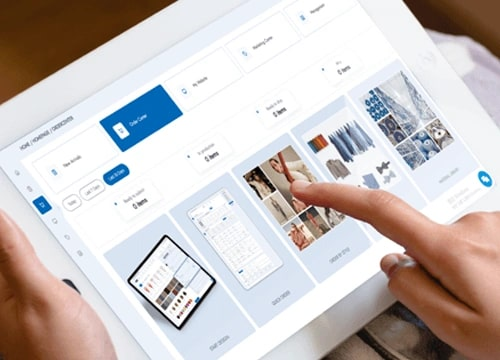
For Custom Clothing Brands: Try Kutetailor
If your focus is on made-to-measure online or personalized apparel, platforms like Kutetailor offer tailored solutions that go beyond traditional e-commerce.
Kutetailor provides:
l A visual product configuration system for MTM suits and garments
l Customizable storefront templates or seamless integration with your existing site
l Real-time inventory and order tracking
l Built-in marketing and analytics tools to grow your brand faster
It’s a powerful option for entrepreneurs building fashion businesses around fit, personalization, or small-batch customization.
8. Implement Marketing and Sales Strategies
You may have amazing designs and a well-organized home-based store—but without smart marketing, your products might never reach your audience. Here’s how to promote your small clothing business with practical, low-cost, and beginner-friendly strategies:
Social Media Marketing: Pick Your Platforms & Plan Your Content
(1) Choose 1–2 Core Platforms:
l Instagram is perfect for visual storytelling—use it to showcase new drops, behind-the-scenes looks, and customer photos.
l TikTok is ideal for viral short-form content—post styling tips, “how it’s made” clips, and trend challenges.
(2) Post Consistently:
l Use free tools like Later or Planoly to schedule posts in advance. Aim for 3–5 posts per week.
l Include a mix of content: product showcases, founder stories, tips, user-generated content, and lifestyle imagery.
(3) Engage with Your Audience:
l Reply to comments, thank customers in DMs, and reshare tagged content to build a loyal community.
(4) Use Hashtags Strategically:
l Combine niche hashtags (#ethicalfashionbrand, #madeinUSAstyle) with trending ones (#ootd, #fashionreels) for wider reach.
Email Marketing: Build Relationships From Day One
(1) Start Collecting Emails Early:
Use free pop-ups on your website to invite visitors to join your list with an incentive—such as “Get 10% off your first order.”(2) Send Regular Campaigns:
l Weekly or bi-weekly emails can include:
l Product restocks and new launches
l Styling inspiration
l Customer features or testimonials
l Limited-time offers or seasonal sales
(3) Create a Welcome Flow:
l Set up an automated welcome email for new subscribers, introducing your brand and encouraging a first purchase.
Content Marketing & SEO: Build Trust Through Value
(1) Launch a Blog on Your Website:
Writing just 1 article per week can dramatically boost your visibility on search engines over time.(2) Basic SEO Tips:
l Include keywords like “affordable women’s fashion,” “sustainable streetwear,” or “handmade dresses USA.”
l Use headings, meta descriptions, and alt text for images.
l Optimize the keywords of your entire website or store, and use correct and searchable keywords.
Influencer & Creator Collaborations: Build Credibility Through Others
l Start with Micro-Influencers (1K–20K followers):
These creators often have high engagement rates and are more accessible. DM or email with a clear pitch: introduce your brand, explain why you admire their content, and offer to send free products in exchange for a review or tag.l Track ROI with Custom Discount Codes or UTM Links
Consider Affiliate Marketing
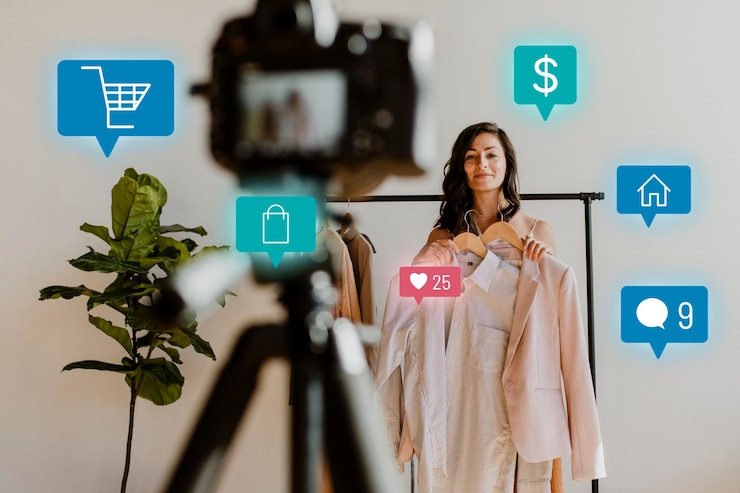
Bonus: Low-Budget Paid Ads (Optional Step)
(1) Test Facebook/Instagram Ads:
n Start with a small budget ($5–10/day) targeting lookalike audiences or website visitors.
n Run ads promoting your bestsellers, email sign-up offer, or seasonal discounts.
(2) Use Pinterest Ads for Evergreen Traffic:
Fashion performs well on Pinterest. Boost pins featuring outfit inspiration or seasonal guides.
9. Manage Operations and Finances
Behind every stylish storefront is a solid operational system.
l Order Fulfillment: Decide whether you’ll ship daily, batch orders weekly, or use a third-party fulfillment service. Pack orders with care—branded packaging elevates customer experience.
l Inventory: Track your stock in Excel, Airtable, or inventory software like Zoho Inventory or Craftybase.
l Finances: Open a separate business bank account. Use tools like Wave or QuickBooks for invoicing and expense tracking.
Ensure you understand local tax laws and register your business if required.
10. Plan for Growth and Scaling
Once you gain traction, you’ll need to plan for what’s next.
l Add new SKUs: Based on customer feedback, seasonal needs, or trending categories.
l Sell in new places: Think Amazon, local boutiques, or weekend pop-up markets.
l Automate: Use tools to auto-send emails, track abandoned carts, and schedule content.
l Hire: Eventually, you may need help with customer service, order packing, or marketing.
Stay flexible—fashion evolves fast, and so should your brand.
Final Thoughts
Launching a home-based clothing business is more than a side project—it’s a chance to build something uniquely yours. With smart planning, a strong brand identity, and consistent execution, you can turn your creativity into a profitable venture. Start small, learn fast, and don’t be afraid to experiment.
Remember: the best time to start was yesterday. The second-best time is today.
MORE 2025-06-01 -
 The Ultimate Guide to Fashion Supply Chain for Your Online Business in 2025
The Ultimate Guide to Fashion Supply Chain for Your Online Business in 2025In 2025, launching a fashion e-commerce brand means navigating a complex global supply chain where a single misstep can cost you customers and profits. From sourcing eco-friendly fabrics to delivering orders in days, the fashion supply chain is the backbone of any successful online apparel business. With consumers demanding transparency and sustainability, mastering your supply chain is more critical than ever. This guide explores how online fashion entrepreneurs can optimize their supply chains for efficiency, sustainability, and customer satisfaction in a rapidly evolving $1.5 trillion industry.
What is the Fashion Supply Chain?
The fashion supply chain refers to the entire journey of a garment—from design and raw materials to production, shipping, and delivery. It’s a complex web of people, processes, and technologies that must work in sync to deliver your product to the end customer. For online businesses, it involves sourcing materials, manufacturing garments, managing logistics, warehousing, and fulfilling orders, all while meeting tight delivery windows and high return rates. Unlike traditional retail, e-commerce faces unique pressures: customers expect fast shipping, high return rates, and global competition.
The globalized nature of the apparel supply chain adds complexity. Raw materials might come from India, manufacturing from China, and sales from the U.S. or Europe. This sprawling network makes efficiency and transparency critical. A well-managed supply chain doesn’t just cut costs—it builds customer loyalty and strengthens your brand in a crowded market.
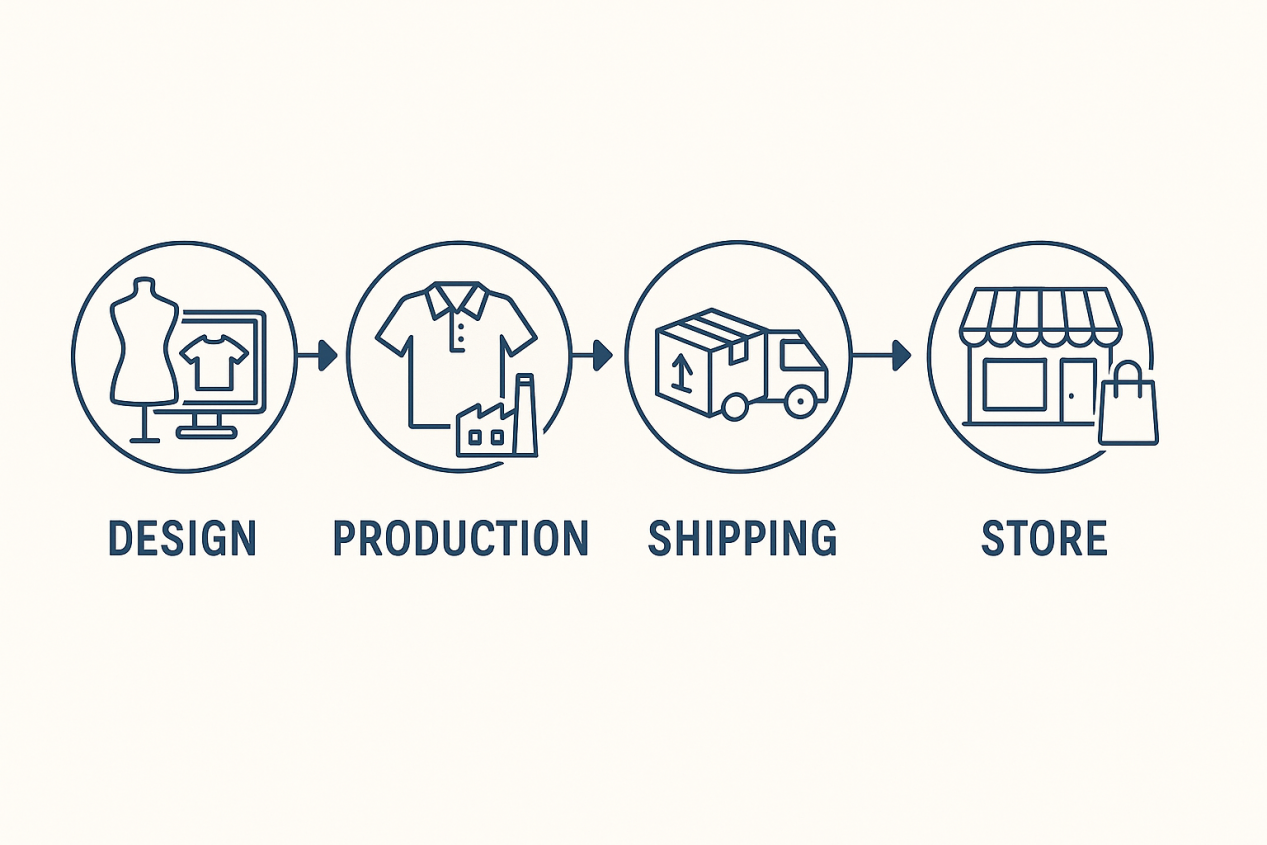
Key Components of Fashion Supply Chain Management
To thrive in e-commerce, you need to master each stage of the supply chain:
1. Design and Product Development
This is where it all begins. The design phase isn’t just about aesthetics—it’s also about functionality, material selection, production feasibility, and time-to-market. Product development involves:
l Trend research and mood boarding
l Sketching and technical design (CAD or tech packs)
l Prototype and sample creation
l Fit testing and revisions
A well-executed design and development process ensures your product is not only on-trend but also manufacturable and scalable.

2. Sourcing and Procurement
Once your designs are finalized, you need to source materials and find the right manufacturing partners. This step involves:
l Selecting fabrics, trims, buttons, and labels
l Choosing suppliers based on cost, quality, and lead time is critical—especially when working with custom apparel suppliers who can meet your brand’s unique material and design needs.
l Negotiating contracts and MOQs (Minimum Order Quantities)
l Ensuring ethical and sustainable sourcing practices
For online fashion businesses aiming to appeal to conscious consumers, transparency and supplier reliability are critical.
3. Manufacturing and Production
This is the heart of the supply chain, where your garments are physically made. Whether you work with local workshops or overseas factories, key steps include:
l Fabric cutting and assembly
l Quality assurance at multiple checkpoints
l Compliance with safety and labor standards
l Batch testing and packaging
Efficient communication with your production partners and having a clear production calendar will help you avoid delays and unexpected costs.

4. Logistics and Distribution
Once your products are made, they need to reach your warehouse—or go directly to your customers. This stage includes:
l Freight forwarding (by air, sea, or land)
l Customs clearance and import/export documentation
l Warehousing and inventory management
l Order fulfillment and last-mile delivery
For e-commerce brands, fast and accurate fulfillment is crucial. Integrating your online store with your logistics system helps streamline operations and reduce fulfillment errors.
5. Retail and Customer Engagement
The final stage is where the product meets the customer—but your job isn’t done yet. This stage involves:
l Presenting products on your e-commerce site with high-quality images, descriptions, and size guides
l Managing customer service, inquiries, and returns
l Collecting feedback and using data to improve future designs
l Handling reverse logistics for returns and exchanges
Customer experience at this stage can make or break brand loyalty. A smooth delivery, easy returns, and excellent communication will turn first-time buyers into repeat customers.
Navigating Logistics in the Fashion Industry
Logistics is the backbone of your supply chain. In fashion, where trends change quickly, delays can cost you both money and credibility.
Common Logistics Challenges:
l Seasonal surges and unpredictable demand.
l Managing returns in a cost-effective way.
l International shipping complexities.
Best Practices to Improve Logistics:
l Automated Warehousing: For faster, error-free order fulfillment.
l Smart Inventory Management: Avoid stockouts and overstock using demand forecasting tools.
l Reliable Fulfillment Partners: Work with 3PL providers that specialize in fashion logistics.
Tip: Offer multiple shipping options and clear return policies to enhance customer trust and satisfaction.
Building a Resilient and Agile Supply Chain
Unpredictable events—like pandemics, strikes, or raw material shortages—can severely disrupt your operations. An agile supply chain can adapt quickly to these changes.
Steps to Increase Resilience:
l Diversify Suppliers: Don’t rely on one region or manufacturer.
l Develop Contingency Plans: Prepare backup logistics routes and stock reserves.
l Stay Informed: Use supply chain monitoring tools to detect potential disruptions early.
Agility also means being able to scale operations based on demand. This is where flexibility in production and fulfillment becomes vital for online retailers.
Leveraging Technology for Supply Chain Excellence
Digital tools are revolutionizing supply chain management in fashion. For online businesses, they enable speed, accuracy, and real-time decision-making.
Essential Technologies to Consider:
l ERP (Enterprise Resource Planning): Unifies data across departments—inventory, sales, finance.
l Blockchain: Offers end-to-end transparency on sourcing and labor practices.
l AI & Analytics: Predict customer behavior, automate restocking, and personalize marketing.
l E-commerce Integrations: Connect platforms like Shopify or WooCommerce with inventory and fulfillment systems for seamless operations.
Bonus Tip: Choose fashion-specific tools like PLM (Product Lifecycle Management) software to streamline design-to-production workflows.
Challenges and Risks in 2025
Running an online fashion business in 2025 comes with hurdles:
l Economic Pressures: Rising tariffs and inflation are squeezing margins, with 39% of fashion executives expecting tougher conditions this year.
l Supply Chain Disruptions: Geopolitical tensions, port strikes, and material shortages threaten delivery timelines.
l Consumer Expectations: Shoppers demand affordability, speed, and ethics—a tricky balance for small brands.
l Scalability: As your business grows, managing multi-channel sales (e.g., your website, Amazon, social platforms) requires robust systems.
Actionable Strategies for Online Fashion Businesses
To build a thriving online fashion brand, focus on these strategies:
1. Build Strong Supplier Relationships: Use supplier scorecards to evaluate performance on quality, ethics, and sustainability. Strong partnerships ensure reliability.
2. Invest in Technology: Adopt AI, RFID, or software like Inventory Planner to boost efficiency, even on a small budget.
3. Prioritize Transparency: Share sourcing details via tools like Digital Product Passports to build customer trust.
4. Optimize Logistics: Work with logistics providers for optimized routes and consolidated warehousing to save time and money.
5. Embrace Agility: Shorten lead times by emulating fast-fashion models, enabling quick responses to trends.
How Kutetailor Simplifies the Supply Chain for Online Fashion Brands
As you’ve seen throughout this guide, managing a fashion supply chain—from design and sourcing to fulfillment—requires agility, transparency, and reliable partners. If you're looking for a real-world tool to tie all these elements together, Kutetailor offers an integrated platform that simplifies the process for online clothing businesses.
Whether you’re building a brand that offers made to measure clothes online or managing small-batch production, Kutetailor supports you with:
l End-to-end production management with real-time tracking
l Visual customization tools for suits, shirts, and personalized apparel
l Flexible order processing and low minimums ideal for new or growing brands
l White-label store setup or API integrations for seamless online experiences
l Centralized dashboards for pricing, styles, and logistics
By integrating design, production, inventory, and fulfillment into a single system, Kutetailor helps modern fashion brands stay lean, agile, and customer-focused—especially in today’s volatile global market.

Conclusion
The fashion supply chain may seem complex, but for your online business, mastering it is essential. From ethical sourcing and streamlined logistics to smart use of technology, every step you optimize brings you closer to better margins, happier customers, and a more resilient brand.
Whether you're just launching your store or scaling your operations globally, building a supply chain that’s agile, transparent, and tech-enabled isn’t just smart—it’s the foundation of long-term success in fashion e-commerce.
Take the time to choose the right tools, partners, and strategies. And remember: fashion moves fast—but with the right supply chain in place, so can you.
FAQs
1. What are the key stages of a fashion supply chain for e-commerce?
It includes sourcing materials, manufacturing, logistics, inventory management, and order fulfillment. Online businesses must optimize for fast delivery and high return rates.
2. How do I manage high return rates?
Use prepaid return labels, recycle items, and apply AI quality control to reduce defects. Analyze return data to improve products.
3. How do I sync production with online sales data?
Use analytics to align production with real-time sales trends, creating feedback loops to adjust inventory dynamically and avoid overstock.
MORE 2025-05-31 -
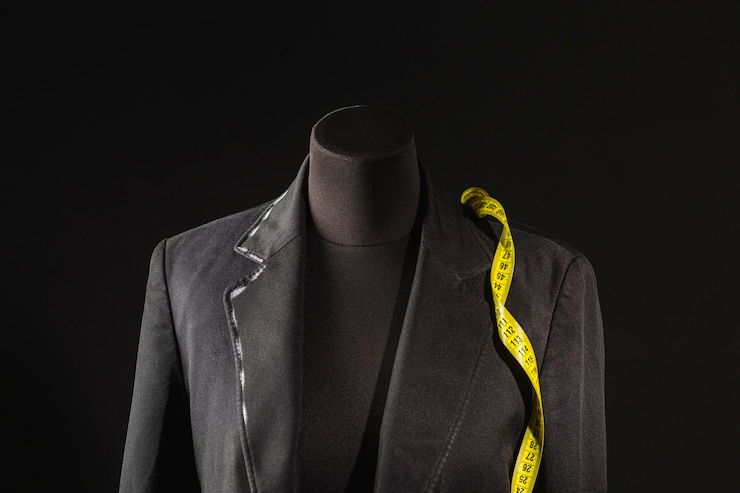 What is Bespoke Clothing? Your Ultimate Guide
What is Bespoke Clothing? Your Ultimate GuideBespoke clothing is custom-made apparel crafted through bespoke tailoring, designed to an individual’s exact measurements and style preferences, offering unmatched fit and personalization. Unlike ready-to-wear or made-to-measure, bespoke involves creating a unique pattern for each client, ensuring a one-of-a-kind garment.
Why Bespoke Clothing Stands Out
Bespoke clothing matters because it solves common fashion frustrations: ill-fitting clothes, generic designs, and low-quality materials. For those with non-standard body types (e.g., tall, petite, or plus-size), bespoke ensures a flattering fit that off-the-rack clothing rarely delivers. It’s also a sustainable choice, as high-quality garments last decades, reducing the need for frequent replacements.
Beyond practicality, bespoke fashion offers a unique experience. Collaborating with a tailor to design a suit, dress, or even a custom shirt lets you express your individuality, making it ideal for weddings, career-defining moments, or simply elevating your everyday style. In a world of fast fashion, bespoke’s craftsmanship and exclusivity appeal to those who value authenticity and long-term value.
How Bespoke Clothing Is Made
Bespoke clothing is crafted like a unique work of art, tailored exclusively for you. The process begins with a consultation, where a skilled tailor takes dozens of precise measurements and explores your vision—perhaps a bold fabric or a timeless cut. A one-of-a-kind pattern is hand-drawn, and the garment is meticulously cut and sewn using premium materials, such as fine wool or soft linen. Typically, the creation takes 8-12 weeks, during which you’ll attend 2-3 fittings to ensure perfection. At these fittings, any imperfections are carefully refined. Artisans invest extra effort in details like collars or cuffs, a labor-intensive process that captures the charm of bespoke clothing—resulting in a garment that perfectly reflects your style and brings your ideas to life. Ultimately, you receive a truly one-of-a-kind piece, unmatched anywhere else.
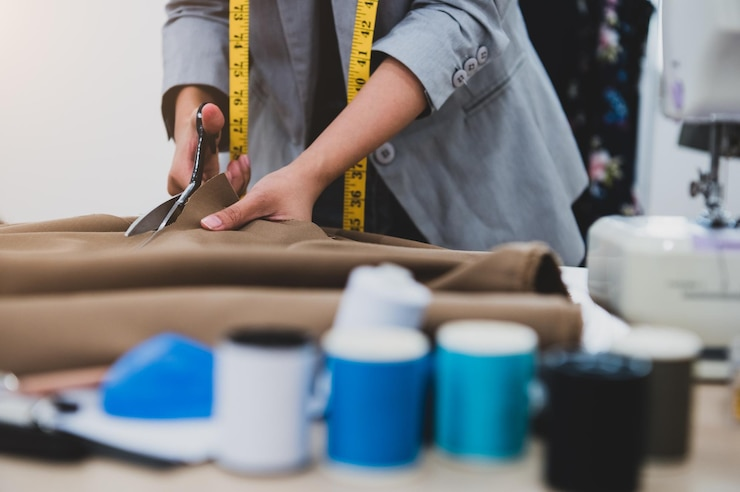
Key Benefits of Bespoke Clothing
Flawless Fit
Bespoke is made for your body, fixing issues like loose shirts or tight skirts. Picture a suit that feels as comfortable as your favorite sneakers, tailored to your exact shape.
Personal Style
You’re in charge—choose fabrics, patterns, or even a special detail, like a coat with a lining inspired by a cherished memory.
Exceptional Durability
Crafted with top-quality materials and meticulous techniques, bespoke lasts for years. For example, a high-quality custom-made dress will remain bright and intact even after being worn countless times.
Bespoke vs. Made-to-Measure vs. Off-the-Rack
· Off-the-Rack: Mass-produced clothes from stores are affordable but often fit poorly, especially for unique body types, and use materials that fade or tear quickly.
· Made-to-Measure: Adjusts a pre-existing pattern to your measurements, with some machine sewing, offering a better fit than off-the-rack but less customization.
· Bespoke: Creates a brand-new pattern with extensive handwork, giving you endless design options and a fit that’s unmatched, though it takes more time.
How to Start Your Bespoke Journey
1. Find a Tailor: Look for experts in bespoke tailoring with excellent reviews and portfolios showcasing diverse styles. Visit their studio to see their craftsmanship, like hand-stitched seams or custom designs.
2. Plan Your Budget: Discuss pricing with tailors to understand costs based on fabric and complexity. Start with a versatile piece, like a tailored blazer, for maximum wear.
3. Book a Consultation: Share your goals (e.g., a wedding suit, everyday dress) and bring inspiration, like photos or sketches. Ask about fabric options and care.
4. Allow Time: Expect 8-12 weeks, including fittings. Plan ahead for events like galas or interviews.
5. Verify Quality: Choose tailors with industry recognition or strong client testimonials to ensure top-notch work.
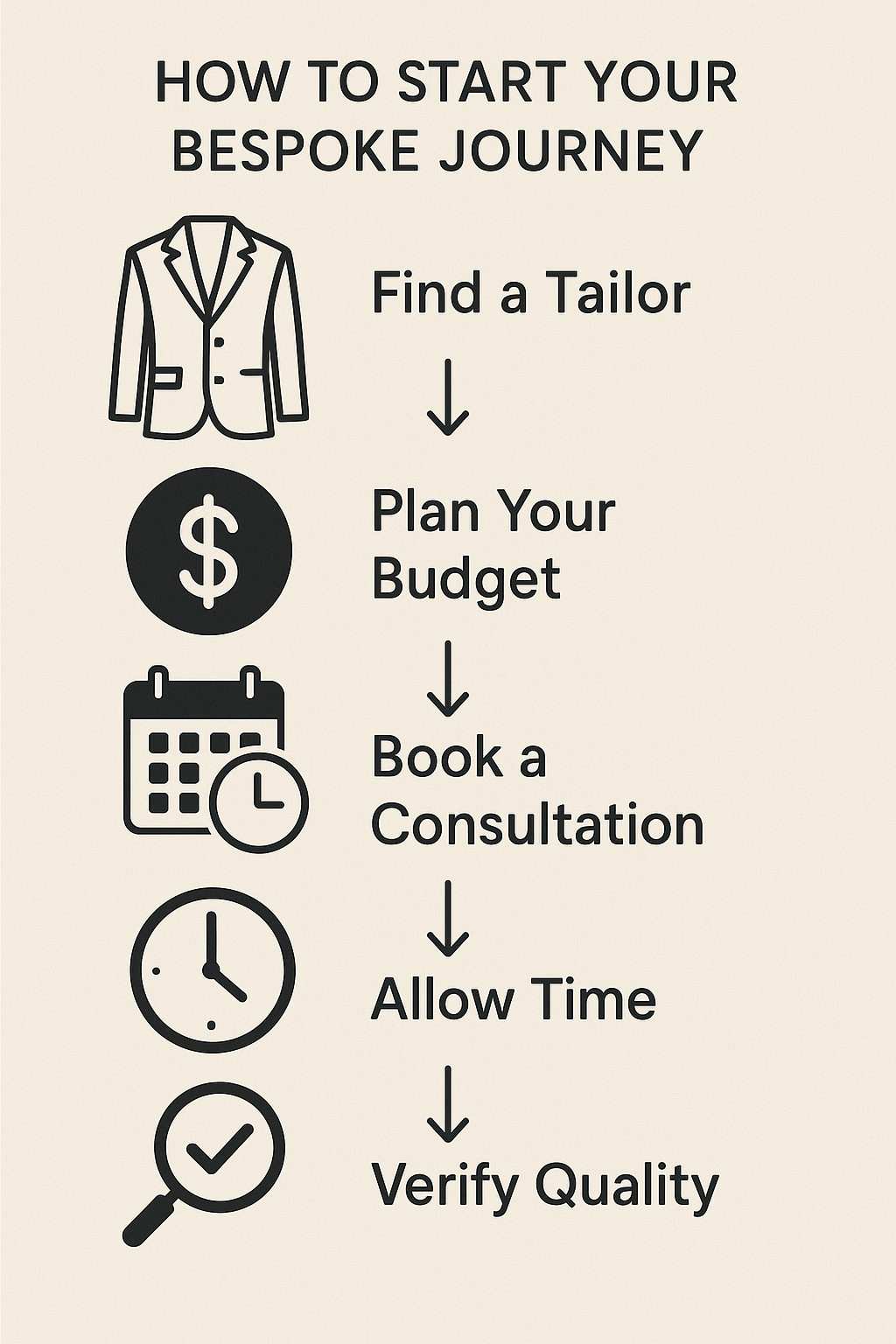
How Much Does Bespoke Clothing Cost?
The cost of bespoke clothing varies depending on the tailor, fabric, and design details, making it hard to pin down a universal price. To get accurate pricing, contact reputable tailors directly for quotes—many offer free consultations or pricing guides on their websites. You can also explore online bespoke platforms, like those specializing in suits or dresses, which often list starting prices or customization options. Comparing quotes from multiple tailors and asking about fabric choices (e.g., cotton vs. luxury wool) will help you find a price that fits your budget.
Can Bespoke Be Casual or for Women?
Yes, bespoke fashion goes far beyond custom formal suits. Tailors craft women’s pieces, from elegant gowns to tailored trousers, with designers showcasing bespoke’s versatility. Casual bespoke, such as custom casual wear like custom jeans or relaxed jackets, is also popular for everyday style.
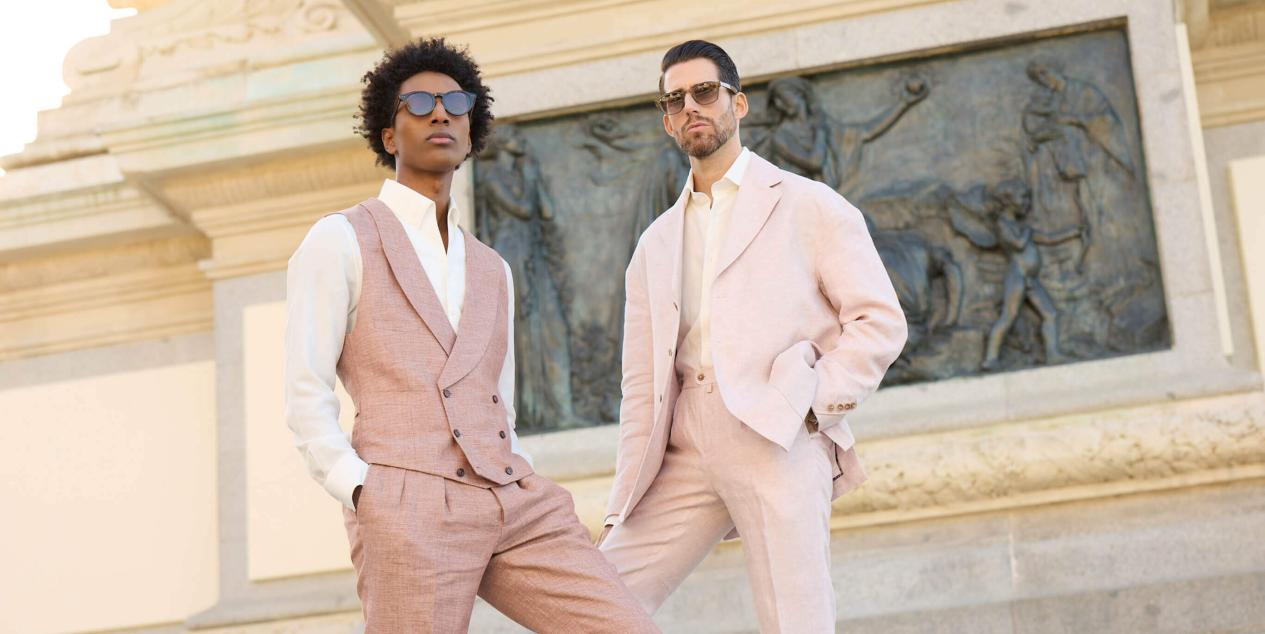
Is Bespoke Clothing Sustainable?
Absolutely—bespoke clothing is eco-friendly because its durable designs last decades, reducing the need for frequent replacements. Many tailors use sustainable fabrics, like organic cotton or ethically sourced silk, helping you build a wardrobe that’s kind to the planet.
How Do I Choose a Reliable Tailor?
Select a tailor with a solid reputation, backed by online reviews and a portfolio of custom work. Visit their workshop to check for quality details, like hand-stitched linings or precise cuts. Ask about their experience, fitting process, and any industry endorsements, such as affiliations with tailoring guilds. Avoid tailors who rush or offer limited design choices.
Final Thoughts
Bespoke clothing offers a perfect fit, personal creativity, and sustainable quality, making it a transformative choice for anyone tired of ordinary fashion. Whether it’s a suit that boosts your confidence or a dress that feels like you, bespoke lets you wear your story. Reach out to a trusted tailor or browse online options to start creating a wardrobe that’s uniquely yours.
MORE 2025-05-30 -
 How to Start an Online Clothing Business: A Step-by-Step Guide
How to Start an Online Clothing Business: A Step-by-Step GuideThinking about starting your own clothing brand online but not sure where to begin? You’re not alone. Thousands of aspiring entrepreneurs search for how to start an online clothing business every month—looking for practical, no-fluff guidance on turning their fashion ideas into reality.
Whether you're dreaming of launching a made-to-measure label, building a sustainable fashion brand, or setting up a print-on-demand store from your bedroom, this step-by-step guide covers everything you need.
1. Define Your Niche and Target Audience
In the saturated world of online fashion, finding your niche isn’t just helpful—it’s essential. A niche helps you attract the right audience, position your brand effectively, and build long-term loyalty.
Examples of strong niches include:
Sustainable fashion made from organic fabrics
Plus-size streetwear with bold prints
Made-to-measure (MTM) suits for professionals
Activewear for women over 40
Once you’ve selected a niche, dig deeper into your target audience:
What are their style preferences?
Where do they shop online?
What problems are they trying to solve with their wardrobe?
Create a customer persona—a fictional profile of your ideal buyer—to guide every decision from product design to marketing.
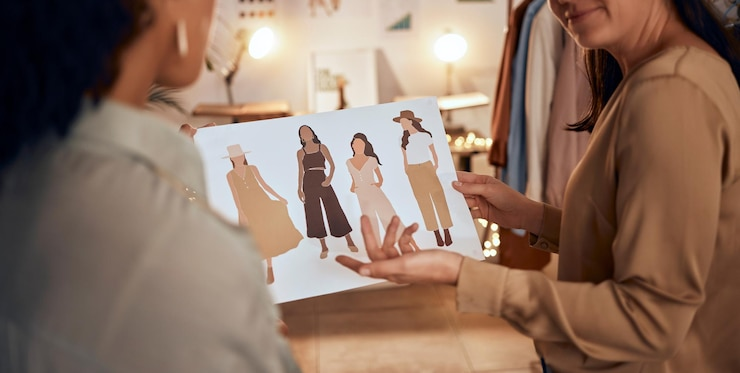
2. Create a Clothing Business Plan
A business plan isn’t just for investors—it’s your roadmap. It helps you clarify your vision and stay focused when challenges arise.
Your plan should include:
Business model: Will you sell inventory you stock yourself? Use a dropshipping model? Or offer print-on-demand or MTM customization?
Startup costs: Factor in website setup, product samples, packaging, branding, and initial marketing.
Revenue goals: Set milestones for your first 3, 6, and 12 months.
Operations strategy: Will you fulfill orders in-house, or partner with a logistics provider?
Marketing plan: Identify key channels (e.g., social media, email, influencers) and how you’ll use them to attract customers.
This is also the time to consider your legal and financial foundations—register your business, open a separate bank account, and explore basic accounting tools.

3. Choose the Right E-commerce Platform
Your e-commerce platform is the foundation of your online store—it should match your business model, be easy to manage, and allow for future growth.
Popular platforms include:
Shopify: User-friendly, scalable, and full of features for ready-to-wear and dropshipping brands.
WooCommerce: A flexible, open-source option for WordPress users with more technical control.
BigCommerce: Known for built-in features and scalability.
Printful / Printify: Great for print-on-demand apparel with design and fulfillment integration.
For custom or made-to-measure (MTM) businesses, platforms like Kutetailor are purpose-built. Kutetailor offers a backend system for tailors, retailers, and designers to manage custom orders, product uploads, and customer measurements. Unlike general platforms, it supports the full MTM workflow—from order entry to production tracking—making it ideal for bespoke apparel brands.
When choosing a platform, consider:
Ease of use for non-developers
SEO and mobile optimization
Payment gateways and shipping options
Integration with tools like email marketing or inventory systems

4. Source or Produce Your Products
Once you’ve decided what kind of clothing you want to sell, you’ll need to figure out how to get it.
You have three main options:
Buy wholesale from established suppliers and resell under your own brand.
Manufacture your own designs, either locally or overseas.
Use on-demand or made-to-measure (MTM) services to customize each product per customer order.
Whichever you choose, always:
Order product samples to evaluate quality firsthand.
Understand lead times and minimum order quantities (MOQs).
Clarify return, defect, and restocking policies before committing.
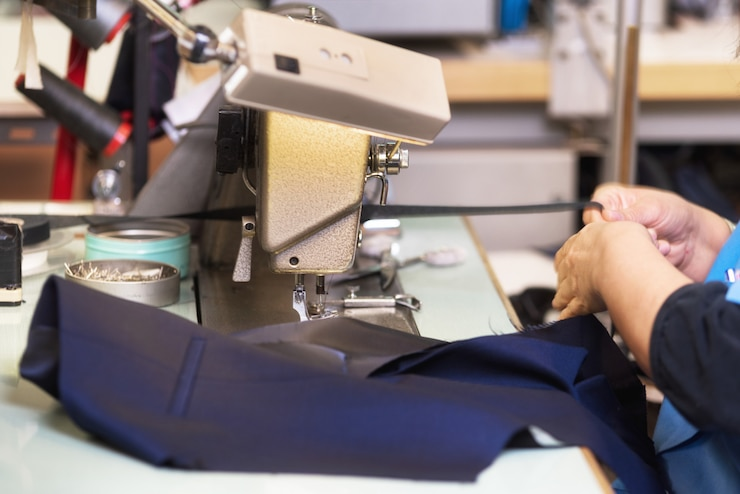
If you're going the custom route, be sure to research and partner with custom apparel suppliers that align with your quality standards and delivery timelines.
5. Build a Unique and Consistent Brand
Your brand is what sets you apart—and it's more than a logo.
Start by defining:
Your brand name and tagline: Memorable and relevant to your audience.
Visual identity: Colors, typography, and imagery that reflect your values.
Voice and tone: Are you playful, minimalist, premium, street-smart?
Make sure your branding is consistent across your website, product packaging, email marketing, and social media channels. The goal is to create a professional and cohesive experience that builds trust with your audience from the first impression.
6. Set Up Your Clothing Online Store
Now it’s time to build your storefront. This is where your customers will browse, fall in love with your products, and hit “buy now.”
A good online store should have:
Clean, intuitive navigation
High-resolution product images and size charts
Persuasive product descriptions
Mobile optimization
Secure checkout and payment processing

For MTM brands, Kutetailor offers a complete online platform tailored for the custom clothing business. Whether you're just starting or already offering made to measure clothing online, Kutetailor provides the infrastructure you need to simplify operations and scale efficiently.
Key features include:20+ website templates for fast, attractive store setup
Visual Order Center: Easily configure suits, shirts, or accessories without any coding
Live order tracking, fabric inventory sync, and real-time updates
Marketing Center: Built-in email and social media tools to automate promotions
Data dashboard for sales analysis and customer behavior insights
With Kutetailor, tailors, designers, and MTM retailers can manage their digital storefront and backend production from one seamless platform.7. Promote Your Brand Online
You’ve built a store—now it’s time to bring in traffic.
Your marketing plan should include a mix of:
Social Media: Platforms like Instagram, TikTok, and Pinterest are ideal for fashion. Focus on high-quality visuals, trending audio, and storytelling.
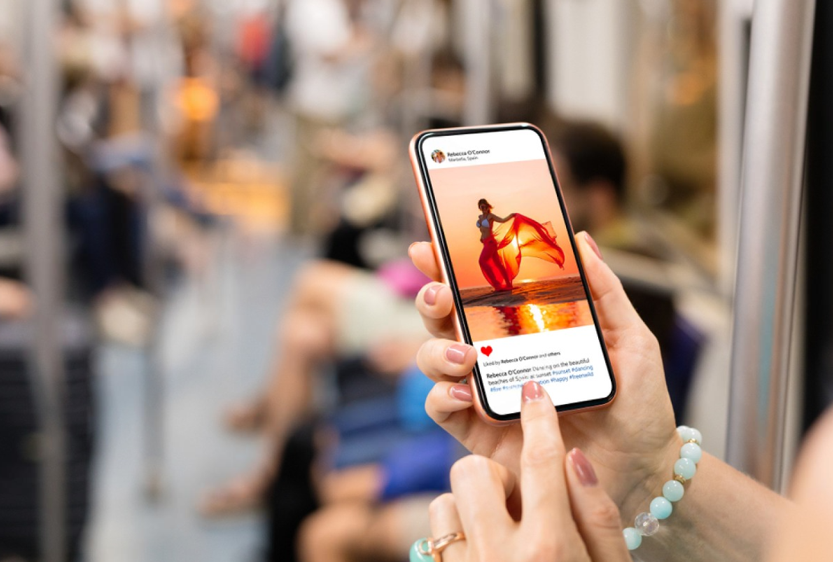
Influencer Collaborations: Work with micro-influencers or niche creators who align with your brand values.
Email Marketing: Set up automated welcome sequences, abandoned cart flows, and new arrival announcements.
Content Marketing: Write blog posts, film behind-the-scenes videos, or share styling tips to drive SEO traffic.
Paid Advertising: Use Facebook Ads or Google Shopping to target specific audiences based on interests and behavior.
Consistency and authenticity are key. Don’t just sell—engage.
8. Manage Logistics and Customer Service
Order fulfillment and support can make or break your brand.
Here’s how to stay on top of both:
1. Shipping: Choose a reliable carrier and be transparent about shipping times and fees.
2. Returns: Offer a clear and fair return policy. This builds customer trust and increases conversion.
3. Customer Support: Provide email or chat support with fast response times. Tools like Zendesk or Gorgias can help.
4. Inventory Management: Use tools to track low stock levels, restock popular items, and forecast demand.

★ If you’re using a fulfillment platform like Kutetailor, many of these processes can be streamlined into your backend workflow.
9. Track Performance and Optimize
You can’t grow what you don’t measure.
Monitor your store’s performance using:
Google Analytics: Track traffic, bounce rates, and user behavior.
Conversion Tracking: Identify which pages are converting—or not.
Email Metrics: Measure open and click rates.
Customer Feedback: Use surveys or reviews to discover what’s working (and what’s not).
Run A/B tests on product titles, images, or homepage layouts. Even small improvements can lead to big gains in revenue over time.
10. Plan for Growth
Once you’ve found traction, it’s time to scale up.
Here’s how:
Launch new products: Expand your collection or introduce limited-edition drops.
Enter new markets: Translate your site or offer international shipping.
Sell across channels: Consider marketplaces like Amazon, Etsy, or Zalando.
Collaborate: Co-brand with influencers or other fashion labels.
Go offline: Host pop-up shops or trunk shows to build community and collect feedback.
Above all, stay agile. The fashion industry moves fast, so continue innovating and listening to your audience.
Final Thoughts
Starting an online clothing business isn’t reserved for big budgets or tech experts. With the right tools, a clear strategy, and a strong brand identity, anyone can build a profitable store that reflects their vision and connects with real customers.
If you're in the custom or made-to-measure space, platforms like Kutetailor offer everything you need to simplify production, launch your site, and grow fast—without needing to code or manage complex workflows.
Still wondering how to start an online clothing store that actually works? Start small. Pick your niche. Choose the right platform. Launch a product. You don’t need to get everything perfect—just get it moving.
Ready to turn your fashion idea into a brand?
Explore platforms, build your first product, and take that first real step today.MORE 2025-05-20 -
 What Is a Tailcoat and How to Wear It
What Is a Tailcoat and How to Wear ItThe tailcoat, one of the most formal garments a man can wear. You may have encountered the term “tailcoat” on an invitation to a white tie event, sparking curiosity about this attire. In modern society, tailcoats are seldom seen, and their strict dress code is known to few, leaving many puzzled about their role in contemporary fashion.
What Is a Tailcoat?
A tailcoat, also known as a dress coat, tuxedo tail, or full dress tail, is a knee-length, double-breasted jacket with a cut-away front and long tails at the back, designed solely for the white tie dress code—the most formal evening attire for men. Made from black or midnight blue wool (often barathea or mohair), it boasts silk-faced peaked lapels, a single center vent, and three non-functional buttons on each side. The tails, reaching the back of the knees, form the iconic “swallow-tail” silhouette, while the snug, unbuttoned fit highlights the torso.
Distinct from the morning coat (used in daytime morning dress) or equestrian shadbelly, the evening tailcoat is a hallmark of prestige. It is widely regarded as the king of all men's clothing.
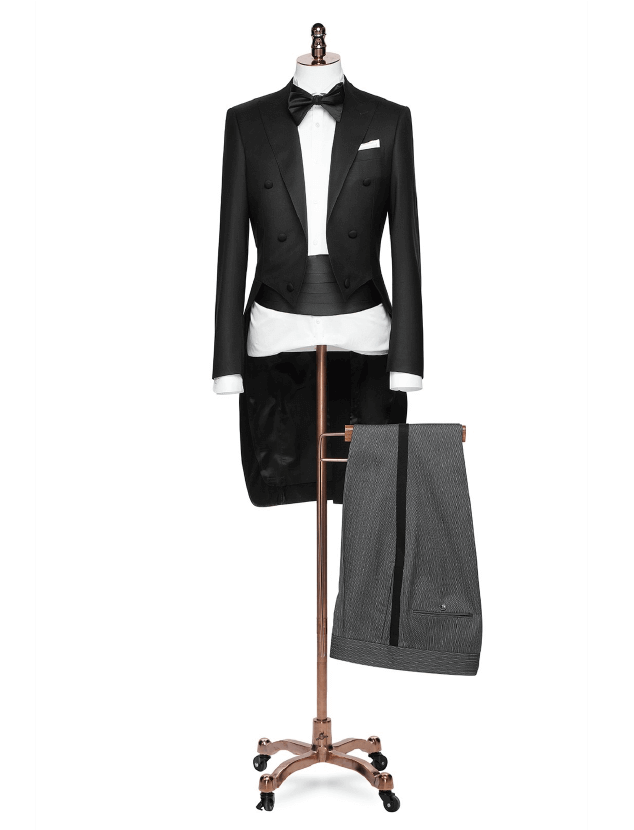
A Brief History of the Tailcoat
The tailcoat traces its roots to the late 18th century, evolving from riding coats with fronts cut for horseback ease. Fashion pioneer George Brummell championed it as formal daywear, but by the 1850s, it became exclusive to white tie eveningwear, supplanting frock coats for daytime formality. The tuxedo (black tie) overtook it in the early 20th century, relegating the tailcoat to the most exclusive evening occasions, with rare daytime exceptions like European diplomatic ceremonies.
Today, the tailcoat shines at high-profile galas and formal banquets, its scarcity enhancing its allure as a symbol of enduring elegance.
When to Wear a Tailcoat
The tailcoat is reserved for white tie events, held after 6 p.m. or sundown, as explicitly stated on invitations. These include:
· Grand balls, like those in historic European palaces.
· Formal state dinners or diplomatic receptions.
· Elite evening gatherings, such as cultural festivals or prestigious award ceremonies.
Daytime wear is rarely acceptable, permitted only when traveling to an evening event or for specific European state functions. The tailcoat is inappropriate for black tie, semi-formal, or casual settings like proms or office parties, where a tuxedo or suit is better suited.
Formality varies by region, with Europe upholding stricter white tie standards. In the U.S., formalwear is more flexible, but white tie remains a rare choice, making the tailcoat a striking statement.
How to Wear a Tailcoat – The White Tie Ensemble
Mastering the tailcoat requires precision, as the white tie ensemble is a harmonious blend of components. Here’s how to style it impeccably:
Core Components
· Jacket: A black or midnight blue tailcoat with silk-faced peaked lapels, tailored for a snug, unbuttoned fit. The tails should reach the back of the knees.
· Trousers: High-waisted, matching the jacket, with double-braided satin stripes for polish.
· Waistcoat: White piqué, single-breasted with a shawl collar, ending above the tailcoat’s front points for clean lines.
· Shirt: White with a stiff, detachable wing collar and bib front, fastened with two or three studs.
· Bow Tie: White piqué, self-tied to reflect authenticity.
Accessories
· Shoes: Patent leather opera pumps with grosgrain bows for tradition, or polished black oxfords for a modern touch.
· Socks: Long black silk socks for a seamless look.
· Optional: White gloves, a top hat, a white linen pocket square, a boutonnière, or a cane for historical flair.
Fit and Tailoring
A tailcoat demands custom formal wear or made-to-measure tailoring. The waistcoat and shirt must not extend below the tailcoat’s front, and the tails should align with the knees. A proper fit enhances posture and elegance.
Styling Tips
· Choose black for tradition or midnight blue for a rich, modern hue under evening light.
· Avoid notch lapels, common in low-quality rentals, and ensure the bow tie suits your face’s proportions.
· Add a monogrammed shirt for a personal touch, ideal for significant events like weddings.
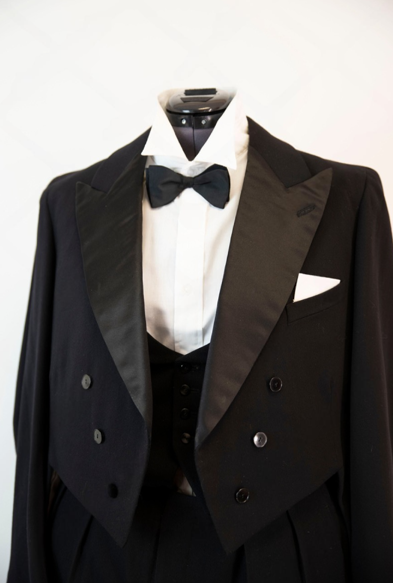
Can You Wear a Tailcoat to a Wedding?
A tailcoat is suitable for a wedding only if the invitation specifies “white tie” and the ceremony or reception starts after 6 p.m., marking an ultra-formal evening event. These are rare, often high-profile weddings. Grooms or groomsmen may don tailcoats to complement a grand bridal vision, perhaps with a boutonnière for distinction.
For most weddings, a tailcoat is out of place. Daytime weddings or those requesting black tie or suits call for a tuxedo or formal suit. In the UK, evening weddings are uncommon, making white tie even less likely. In the U.S., some daytime weddings may misuse tailcoats due to relaxed norms, but this strays from tradition—always confirm with the couple.
Etiquette and Tips
· Check the dress code: Consult the couple or planner to avoid overdressing, which could clash with the event’s tone.
· Guest vs. Groom: As a guest, ensure your tailcoat doesn’t overshadow the groom. As a groom, coordinate with the bridal party, perhaps matching the bride’s gown with white tie elegance.
· Renting: For a one-time event, rent from trusted services, ensuring a tailored fit to avoid a boxy appearance.
· Comfort: Practice moving in the tailcoat—sitting, standing, dancing—to feel confident during the ceremony and reception.
A tailcoat at a white tie wedding is a bold, elegant choice, but it requires careful adherence to the event’s formality.
What Is the Difference Between a Tailcoat and a Tuxedo?
The tailcoat (white tie) and tuxedo (black tie) are distinct formal eveningwear options, often confused due to their refined looks. Here’s how they differ:
Feature Tailcoat (White Tie) Tuxedo (Black Tie) Formality Highest level; for state dinners, grand balls Less formal; suitable for galas, proms, weddings Jacket Design Long tails, cut-away front, silk-faced peaked lapels Shorter length, satin lapels (peaked/shawl/notch) Accessories White piqué waistcoat, wing-collar shirt, white bow tie Black cummerbund/waistcoat, pleated shirt, black bow tie Shoes Patent leather opera pumps Patent leather oxfords or loafers Occasions Strictly white tie after 6 p.m., rare occasions Common for black tie or optional events, including some daytime ones Extra Items Optional: Top hat, white gloves Optional: Colored pocket square, modern cufflinks 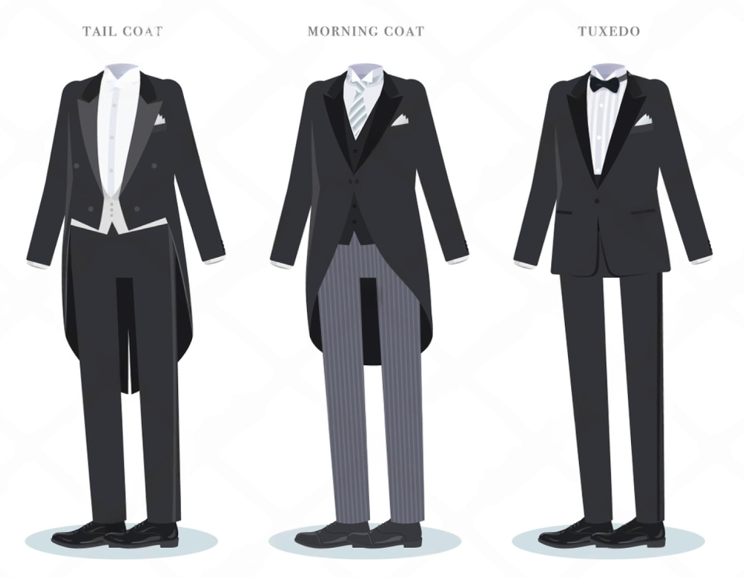
Check the invitation’s dress code to choose correctly. Tuxedos fit most modern formal events, while tailcoats shine in confirmed white tie settings.
Conclusion
The tailcoat is the epitome of men’s formalwear, perfect for white tie events like lavish evening weddings or grand balls, distinct from the more adaptable tuxedo. Its history, precise styling, and exclusivity make it a beacon of sophistication. Whether you’re stepping into a high-society wedding or a cultural gala, the tailcoat elevates any moment into timeless elegance. For broader formal occasions, a tuxedo may suffice, but the tailcoat awaits those ready to embrace tradition. If you’re sourcing high-end garments for clients or events, working with custom apparel suppliers ensures access to tailored pieces that meet white tie standards.
MORE 2025-05-17 -
 Satmar vs. Chabad Kapote: Understanding the Differences
Satmar vs. Chabad Kapote: Understanding the DifferencesThe kapote — the distinctive long black coat — is a central garment in Hasidic Jewish culture, worn by men as a symbol of modesty, tradition, and religious commitment. While many Hasidic groups share this traditional attire, the nuances between them are meaningful. In particular, Satmar and Chabad, two prominent Hasidic sects, exhibit notable differences in the style, use, and symbolism of their kapotes.
Historical and Cultural Context
Understanding the kapote begins with appreciating the distinct backgrounds of Satmar and Chabad.
Satmar, founded by Rabbi Joel Teitelbaum in Hungary, is known for its strict traditionalism and emphasis on community insularity. Preserving old-world customs is central to Satmar identity, and this conservatism is deeply reflected in their dress.Chabad-Lubavitch, originating in 18th-century Russia under Rabbi Schneur Zalman of Liadi, takes a more outward-facing approach. Chabad is deeply involved in outreach ("kiruv"), aiming to engage and inspire Jews around the world. Their attire, while traditional, often embodies a subtle balance between reverence for heritage and readiness to engage the modern world.
Thus, the philosophies of these groups naturally influence their approach to the kapote — how it is designed, when it is worn, and what it symbolizes.
Design and Tailoring Differences
While both Satmar and Chabad communities wear kapotes, their designs reflect different priorities and philosophies. The table below summarizes the key distinctions:
Feature Satmar Kapote Chabad Kapote Fabric and Texture High-quality silk or satin, formal sheen Durable wool or polyester blend, practical texture Cut and Fit Loose, flowing, modest emphasis More structured and fitted, balancing tradition and modernity Buttons and Embellishments Multiple rows of buttons, some subtle decorations Simple design, usually one row of buttons, minimalistic These differences, though subtle to an untrained eye, carry significant meaning within each community’s cultural and religious framework.
Occasions and Usage
Satmar Practices
For Satmar men, the kapote is predominantly worn during Shabbat, Jewish holidays, weddings, and significant religious events. It’s not typically daily wear. The donning of the kapote is an elevated act, signifying respect for sacred times.Chabad Practices
Chabad men, particularly rabbis and emissaries, often wear their kapote daily. Whether attending morning prayers, conducting Torah classes, or running community programs, the kapote serves as a symbol of their constant religious mission.
This daily usage also explains the preference for more durable fabrics and slightly more practical designs compared to the ceremonial richness of Satmar kapotes.
Symbolism, Identity, and Community Perceptions
Though the Satmar and Chabad kapotes appear outwardly similar, their symbolic meanings and community expectations differ profoundly.
For the Satmar community, the kapote represents a form of religious defense — a visible barrier against the secular world. It embodies separation, preserving purity by minimizing external influences. Wearing the kapote reinforces internal solidarity and a commitment to insularity, emphasizing community cohesion over engagement with broader society. Uniformity in dress is highly valued; small variations are discouraged to maintain a strong, collective identity.
In contrast, for Chabad, the kapote serves as a symbol of religious mission and outreach. It is not just about preserving personal piety but about actively engaging others. A Chabad emissary wearing a kapote is a living ambassador of Jewish tradition, ready to teach and inspire wherever he goes.
While Chabad maintains a traditional dress code, there is slightly more room for personal adaptation — tailoring choices, material preferences, and climate adjustments — so long as the core standards of dignity and modesty are preserved.
This flexibility reflects Chabad's broader openness to engaging diverse environments without compromising fundamental values.In essence, while both kapotes signify devotion, Satmar’s version leans inward toward protection and uniformity, whereas Chabad’s leans outward toward mission and adaptability.

Custom Kapota Tailoring
For those seeking garments that align precisely with their community's traditions and personal requirements, custom kapote tailoring is an ideal solution. Whether following Satmar’s ceremonial design or Chabad’s practical daily style, custom tailoring ensures the kapote fits appropriately, uses suitable materials, and reflects the intended cultural symbolism.
If you want to make custom kapotas in bulk, look for experienced custom apparel suppliers to make them.
Conclusion
The kapote stands as a powerful symbol in both Satmar and Chabad communities — a garment woven with threads of faith, history, and philosophy. Yet the differences in fabric, fit, frequency of use, and meaning reflect the unique journeys of each group.
Understanding these distinctions offers more than just a lesson in Hasidic fashion — it opens a window into how clothing can mirror the deepest values and missions of a community. Whether flowing silk or tailored wool, each kapote tells a story of devotion, identity, and purpose.
MORE 2025-05-17

